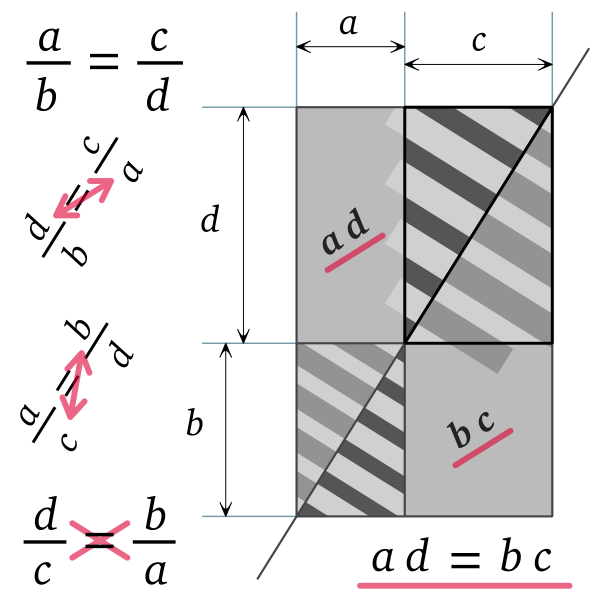Archivo: Academ homothetic rectangles

Descripción: When the duplication of a given rectangle preserves its shape, the ratio of its large dimension to the small one is a constant number in all the copies, equal to the original ratio. The largest rectangle of the drawing is similar to one or the other rectangle with stripes. From their width to their height, the coefficient of proportionality is: dc=ba=d+bc+a. {\displaystyle {\tfrac {\,d\,}{c}}\,=\,{\tfrac {\,b\,}{a}}\,=\,{\tfrac {\,d\,+\,b\,}{c\,+\,a}}.\ } The value of each ratio Horizontally written within the image, at the top or the bottom, the value of each ratio determines the common shape of the three similar rectangles. If we define the shape of any rectangle by the ratio of its large dimension to its small one, we get a bijective correspondence between all the rectangular shapes and all the real numbers greater than or equal to 1. The ratio equals 1 if and only if the shape is square. The multiplicative inverses of all these ratios compose the interval of all the real numbers that are strictly positive and less than or equal to 1. The common diagonal of the similar rectangles divides each rectangle into two superposable triangles, with two different kinds of stripes. The four striped triangles and the two striped rectangles have a common vertex: the center of an homothetic transformation with a negative ratio −k or −1k, {\displaystyle \,-k\ {\text{ or }}{\tfrac {\,-\,1\,}{k}},\ } that transforms one triangle and its stripes into another triangle with the same stripes, enlarged or reduced. Between the corresponding sides lengths of two homothetic triangles, the proportionality constant is the duplication scale, equal to a ratio obliquely written within the image: ca=k or ac=1k.{\displaystyle {\tfrac {\,c\,}{a}}\,=\,k\ {\text{ or }}\ {\tfrac {\,a\,}{c}}\,=\,{\tfrac {1}{\,k\,}}.}In the following proportion: ab=cd,{\displaystyle \,{\tfrac {\,a\,}{b}}\,=\,{\tfrac {c}{\,d\,}},\,} a and d {\displaystyle \,a{\text{ and }}d\ } are called the extremes, while b and c are the means, because a and d are the extreme terms of the list (a, b, c, d), {\displaystyle \,(a,\ b,\ c,\ d\,),\ } while b and c are in the middle of the list. From any proportion, we get another proportion by inverting the extremes or the means. And the product of the extremes equals the product of the means. Each double arrow of the image indicates two inverted terms of the first proportion. From one half the surface of the largest rectangle, we get a plain gray rectangle either above or below the common diagonal of the similar rectangles, by removing two triangles with two different kinds of stripes. Above and below this diagonal, the areas of the two biggest triangles of the drawing are equal, because these triangles are superposable. Above and below the subtracted areas are equal for the same reason. Therefore the plain gray rectangles have the same area: a d = b c.
Título: Academ homothetic rectangles
Créditos: Trabajo propio
Autor(a): Baelde
Términos de Uso: Creative Commons Attribution-Share Alike 3.0
Licencia: CC BY-SA 3.0
Enlace de Licencia: https://creativecommons.org/licenses/by-sa/3.0
¿Se exige la atribución?: Sí
Usos del archivo
La siguiente página enlaza a este archivo:

